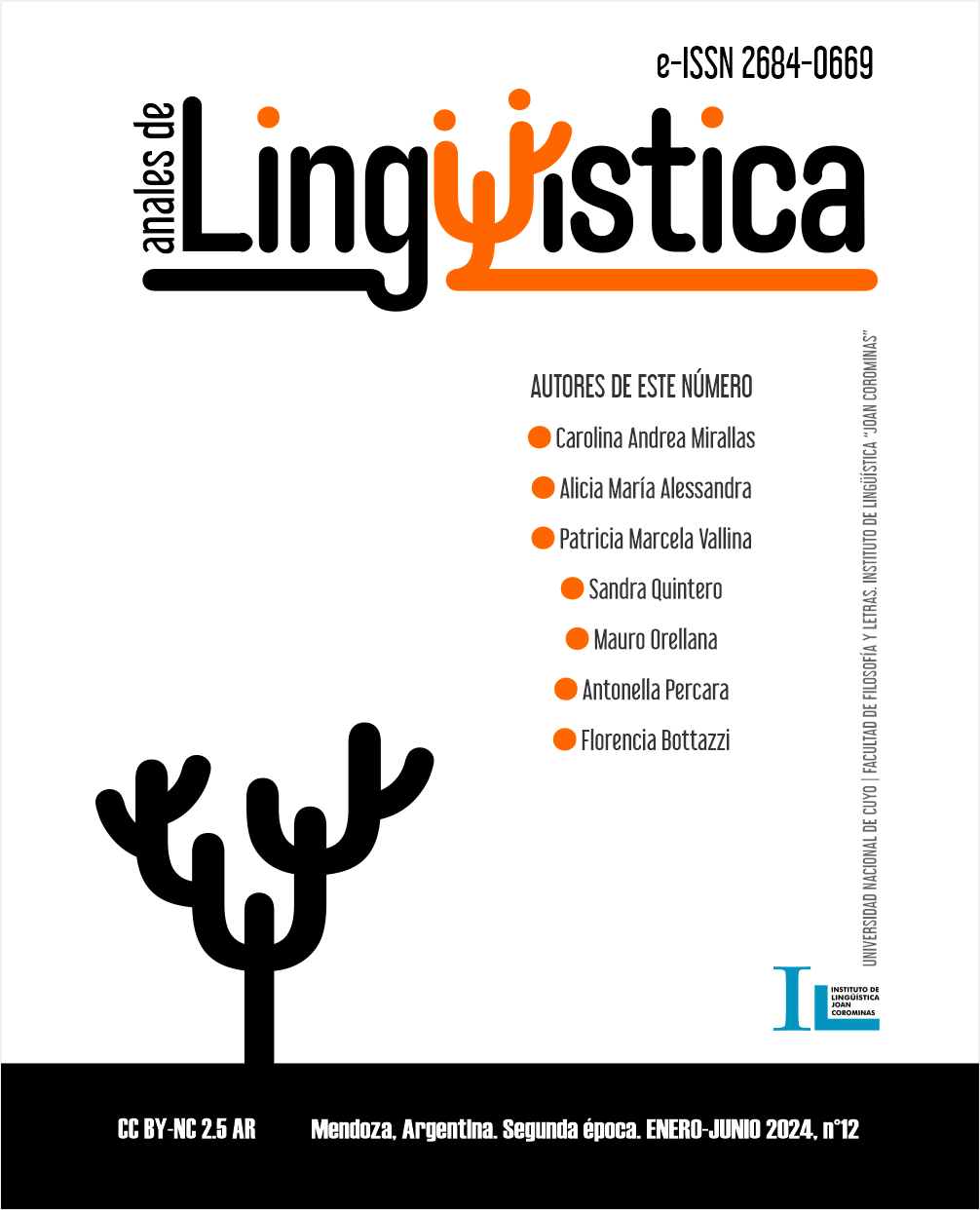Protesta y reclamo en el paisaje lingüístico escolar
Palabras clave:
paisaje lingüístico, microdiscurso, top down, bottom upResumen
Las presentes líneas recogen las principales actividades realizadas como integrantes en el marco del proyecto de investigación Observatorio de la lengua regional: La lengua en el paisaje de las escuelas mendocinas. Esta investigación, que comenzó en el año 2019, registra, describe y analiza las distintas expresiones lingüísticas del paisaje exterior e interior de escuelas mendocinas urbanas.
Entendemos por paisaje lingüístico (en adelante, PL) a todo texto escrito en calles, edificios y sitios de acceso público como, cartelería, anuncios, graffitis, entre otros, y que manifiestan un uso especial del lenguaje ligado a funciones sociales, informativas y simbólicas; es un marcador del poder y estado de las comunidades lingüísticas que habitan un territorio (Laundry y Bourhis: 1997).
El análisis realizado sobre el PL del Departamento de Aplicación Docente, UNCuyo (en adelante DAD) se ajusta a los lineamientos teóricos y metodológicos propuestos por diversos autores, tales como Rodrigue Landry y Richard Bourhis (1997), Muñoz Carrobles (2010), Pons Rodríguez (2012), Mónica Castillo Lluch y Daniel Sáez Rivera (2013). Dicho análisis se enriquece también, con conocimientos de la lingüística cognitiva.
Esta investigación es de tipo exploratoria. El corpus está integrado por fotos de cartelería, letreros, graffitis, escritos en paredes exteriores e interiores del DAD producida en septiembre del 2021, como consecuencia de una situación conflictiva suscitada en la Institución y que tuvo un fuerte impacto en toda la comunidad educativa del colegio. La unidad de análisis considerada es el microdiscurso, unidad de la lengua en uso puesta en función en situaciones efectivas de comunicación.
Podemos afirmar que siempre hay PL y que este es cambiante y responde a las necesidades de los hablantes y a situaciones comunicativas concretas. De esta forma se observa que el PL es un entramado que se modifica de acuerdo con las preocupaciones, las necesidades, los intereses, emociones y pensamientos de las comunidades que lo contienen. Concluimos que en el PL exterior e interior del DAD, se manifiesta una marcada libertad de expresión de los adolescentes y el modo en que se hace visible.
Citas
Backhaus, P. (2006). Linguistic Landscapes: a comparative study of Multilinguism in Tokyo. Multilingual Matters.
Ben Raffael, E., Amara, M. y Shohamy, E. (2006). Linguistic Landscape as Symbolic construction of the Public Space: The case of Israel. International Journal of Multilinguism, 3 (1), 7-30.
Castillo Lluch, M. y Sáez Rivera, D. (2011). Introducción al paisaje lingüístico de Madrid. Lengua y migración, 3 (1), 73-88.
Hipperdinger, Y. (2020). Paisaje lingüístico institucional en el área dialectal bonaerense: La promoción de la enseñanza de lenguas. Cuadernos de Literatura. Revista de Estudios Lingüísticos y Literarios, 15, 50-62.
Landry, R., y Bourhis, R. (1997). Linguistic Landscape and Ethnolinguistic Vitality: An empirical studio. Journal of Language and Social Psychology. 16 (1), 23-49.
Muñoz Carrobles, D. (2010). Breve itinerario por el paisaje lingüístico de Madrid. Ángulo recto. Revista de estudios sobre la ciudad como espacio plural , 2 (2), pp. 103-109. https://www.academia.edu/105913131/Breve_itinerario_por_el_paisa je_ling%C3%BC%C3%ADstico_de_Madrid?uc-sb-sw=24139892
Pons Rodríguez, L. (2012). El paisaje lingüístico de Sevilla y variedades en el escenario urbano hispalense. Diputación de Sevilla.
Ullmann, S. (1967). Semántica. Introducción a la ciencia del significado. Aguilar.
Descargas
Publicado
Cómo citar
Número
Sección
Licencia
Derechos de autor 2024 Alicia María Alessandra, Patricia Marcela Vallina
Esta obra está bajo una Licencia Creative Commons Atribución 2.5 Argentina.
Los/as autores/as que publican en esta revista están de acuerdo con los siguientes términos:
1. Los/as autores conservan los derechos de autor y garantizan a la revista el derecho de ser la primera publicación del trabajo bajo una licecncia Creative Commons Atribución 2.5 Argentina (CC BY 2.5 AR) . Por esto pueden compartir el trabajo con la referencia explícita de la publicación original en esta revista.
2. Anales de lingüística permite y anima a los autores a difundir la publicación realizada electrónicamente, a través de su enlace y/o de la versión postprint del archivo descargado de forma independiente.
3. Usted es libre de:
Compartir — copiar y redistribuir el material en cualquier medio o formato
Adaptar — remezclar, transformar y construir a partir del material para cualquier propósito, incluso comercialmente.























